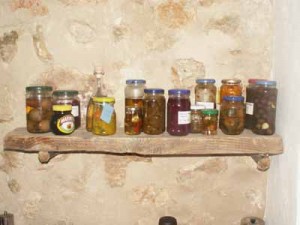Right then, continuing the ‘Preserves – Basics’ theme. This is some information that you need to know about the ingredients you’ll be using.
Fruit and Vegetables
These must be in good condition before you preserve them. So disgard anything spoilt, over-ripe or rotten. You don’t want to introduce any moulds or fungus into the product before you even start the preserving process.
Beware of coatings to commercially produced fruit. Wax coatings on citrus and other fruit should be scrubbed off or peeled.
Pickling is a good way to use up any under-ripe overly firm items. Green tomatoes are a traditional ingredient in many pickles. Things should be firm and clean. That way they will hold up under the pickling process and will last well.
Vinegars
Vinegars must have an acetic acid content of at least 5% to be used safely in pickling. Use whatever type of vinegar you like so long as the acetic acid is high enough. Don’t forget the acid content can be diluted by the contents of the pickle so if your pickle wil be watered down by moisture and juices from vegetables ensure you use a high acid vinegar. The types most often used in pickling are:

ok the marmite’s not homemade
- Malt Vinegar (8% acetic acid) which is dark in colour and strong in flavour so best with strong chutneys and pickles.
- Distilled Malt Vinegar is identical but clear so better for making clear pickles and light preserves.
- Wine Vinegar (usually 6% acetic acid) comes in red or white. White wine vinegar is milder, so good with delicate preserves. Red wine vinegar is slightly heartier and good for spiced fruits.
- Sherry Vinegar is slightly sweet with quite a strong flavour.
- Cider Vinegar is slightly sharp with a fruity flavour.
- Rice Vinegar is very mild and traditionally used for pickling ginger.
- Balsamic Vinegar is smooth and mellow. It is too low in acetic acid to be used as the primary pickling agent. Only use as a flavouring at the end of the cooking.
- Pickling Vinegar is available commercially. It is usually made with malt vinegar and selected spices but there is no reason not to make your own. To make simply steep the spices of choice in vinegar for 1 to 2 months. If you want the spiced vinegar more quickly bring the vinegar to the boil before pouring over the spices and steeping overnight. Allspice berries, peppercorns, coriander seeds, mustard seeds, cinnamon sticks, dried chillies and nutmeg are all suitable. Whole spices are best as powdered spices may leave a cloudy finish. Hardy herbs such as thyme or rosemary and garlic also work well.
Salt
Kosher, preserving, table, rock or sea salt?
To be honest any salt is fine for preserving but if you want a clear pickle such as dill cucumber pickles you really need a kosher/preserving/rock salt. This is because salts for general table use contain anti-caking agents which can make brine and pickles cloudy. No need to worry if you’re making a batch of thick chutney but worth considering for clear pickles. The anti-caking agent doesn’t affect the quality of the preserve just its look.
Brine is often used in the initial stages to reduce the moisture content of your vegetables. Dry brine is just salt layered between the vegetables to draw out excess water. Wet brine is a solution of salt in water which vegetables are soaked in initially to draw out water. Wet brine is also used later on to provide the actual preserve medium. The most common strength of brine called for is a 10% brine solution so these are the ratios to use for that:
10% brine = 50g/2oz salt for every 600ml/1 pint of water.
Sugar
Sugar is particularly important in sweet preserves; jams, jellies and marmalade rely on sugar for their keeping quality and also use sugar to help them set. Again you can use any sugar you like but there can be slight differences to the end result.
White sugars will provide clear, set, sweet preserves and comes in many varieties suitable for preserving:
- Granulated sugar is more coarse and less expensive than caster sugar (used for baking) giving clear results.
- Preserving sugar will give you the clearest preserves due to the arge irregular crystals.
- Jam sugar is preserving sugar with added pectin and citric acid. This helps when making jams with low-pectin fruits but reduces storage time to around 6 months.
Brown sugars give more flavour and obviously more colour to preserves. The choice of using demerara/raw sugar, golden granulated, soft brown, palm, jaggery or molasses sugar is entirely personal. All will work but they will change the flavour and look of both sweet and savoury preserves.
Alcohol
When using alcohol as a preservative it must have an ABV (alcohol by volume) of at least 40%. Any less and you need to combine the alcohol with sugar or heat treat the product to ensure good keeping qualities. For that reason spirits are my preservative of choice!
So that’s about it – get preserving, chutneying, pickling and jamming! There is oodles to know on this subject but we don’t need to know it all to make some fabulous home preserves.
For a more self sufficient future